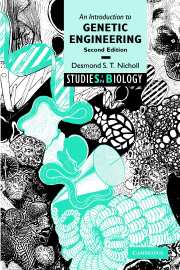Book contents
- Frontmatter
- Contents
- Preface to the second edition
- 1 Introduction
- Part I The basis of genetic engineering
- 2 Introducing molecular biology
- 3 Working with nucleic acids
- 4 The tools of the trade
- Part II The methodology of gene manipulation
- Part III Genetic engineering in action
- Suggestions for further reading
- Using the World Wide Web
- Glossary
- Index
2 - Introducing molecular biology
Published online by Cambridge University Press: 05 June 2012
- Frontmatter
- Contents
- Preface to the second edition
- 1 Introduction
- Part I The basis of genetic engineering
- 2 Introducing molecular biology
- 3 Working with nucleic acids
- 4 The tools of the trade
- Part II The methodology of gene manipulation
- Part III Genetic engineering in action
- Suggestions for further reading
- Using the World Wide Web
- Glossary
- Index
Summary
In this chapter I present a brief overview of the structure and function of DNA, and its organisation within the genome (the total genetic complement of an organism). This provides the non-specialist reader with an introduction to the topic, and may also act as a useful refresher for those who have some background knowledge of DNA. More extensive accounts of the topics presented here may be found in the textbooks listed in Suggestions for further reading.
The flow of genetic information
It is a remarkable fact that an organism's characteristics are encoded by a fourletter alphabet, de fining a language of three-letter words. The letters of this alphabet are the bases adenine (A), guanine (G), cytosine (C) and thymine (T), with triplet combinations of these bases making up the ‘dictionary’ that is the genetic code.
The expression of genetic information is achieved ultimately via proteins, particularly the enzymes that catalyse the reactions of metabolism. Proteins are condensation heteropolymers synthesised from amino acids, of which 20 are used in natural proteins. Given that a protein may consist of several hundred amino acid residues, the number of different proteins that may be made is essentially unlimited; thus great diversity of protein form and function can be achieved using an elegantly simple coding system. The genetic code is shown in Table 2.1.
The flow of genetic information is unidirectional, from DNA to protein, with messenger RNA (mRNA) as an intermediate.
- Type
- Chapter
- Information
- An Introduction to Genetic Engineering , pp. 11 - 26Publisher: Cambridge University PressPrint publication year: 2002

